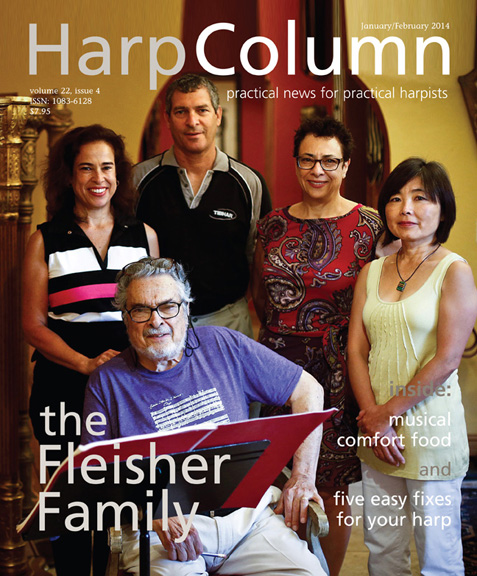Billy Joel isn’t just the piano man anymore.
—by Jan Jennings
Billy Joel has been a pop icon for decades. Although he hasn’t released an album of new songs in 20 years, his Grammy-winning, multi-platinum songs are among our most beloved standards. It is our good fortune that Hal Leonard recently published a collection of 10 of his songs. Billy Joel for Harp features two arrangements of each song by Emily Brecker. The first is intermediate level for pedal harps or “large” lever harps tuned to E-flat and is notated for both instruments. The second is easier and suitable for small lever harps tuned to C (and playable on lever harp tuned to E-flat with no re-tuning).
[protection_text]
The first selection is the haunting ballad, “And So It Goes.” The pedal harp version is fairly simple and sight-readable by intermediate to advanced players. The small harp version has no lever changes. Instead, Ms. Brecker substitutes a different note, or ignores or omits the accidental, while still maintaining the basic harmony of the original.
“Don’t Ask Me Why” is more difficult. In spite of the suggested tempo of “moderately,” this is a lively piece that needs to move at a pretty good clip if you want it to sound the way Billy Joel recorded it, making the lever changes more challenging. The small harp arrangement has simpler rhythms, fewer lever changes (although there are still several), and minor alterations to the melody. They both have some tapping on the soundboard and some scale glisses.
“Honesty” is not difficult on pedal harp but has numerous lever changes. The small harp version is very straightforward.
“I’ve Loved These Days” is a very pretty arrangement. Ms. Brecker uses some accent marks to delineate the melody from the accompaniment. These really are needed on all the pieces, rather than just the few included in some of these renditions, unless the lyrics are going to be included in the body of the music, or the music is written with a separate rhythmic line for harmony like piano music. If you don’t know the piece, you can’t put the emphasis where it belongs. Fortunately today almost everyone has access to YouTube where we can usually hear the original artist performing a piece—an option we should use!
Small harps in C will have to tune a B to flat in their version of “An Innocent Man.” Both versions have a rhythmic, Caribbean feel.
There is minimal accompaniment on “The Longest Time.” Presumably, this is because the original was usually sung a capella. However, because of the limited range used in the left hand, the accompaniment sort of collides with the melody in some places, dampening it almost immediately. This arrangement would be more interesting with a stronger and more prevalent bass. The small harp version eliminates the need to move some levers, but this is hardly necessary, because even small harps could use the more advanced version with little increase in difficulty.
There are no pedal or lever changes on “Piano Man.” The pedal harp version is nine pages long compared to four pages for the small harp. Both versions use some p.d.l.t. to distinguish the instrumental interludes from the melody. The more advanced arrangement uses some varied left hand accompaniment on subsequent verses, but the differences are fairly subtle so it’s still a bit long for an instrumental. After all, one of the distinctive things about Billy Joel’s music is that it often tells a story. Without a singer, the audience might not know all the words and be bored by too many repeated verses. (Remember: the public has a short attention span!)
“She’s Got a Way” is an absolutely lovely arrangement with nice voicings, larger chords, and using a bigger range of the harp. Small harps tuned to C will have to tune a B to flat.
“Summer, Highland Falls” is also quite appealing, but a little more difficult as you should play it at a faster tempo than marked to mimic the movement of the original. This is also true of “You’re My Home” which is reasonably fast-paced rather than “moderate.” This last piece is another example of the need for more clarification of the melody versus the harmony.
It is so important for instrumentalists to dynamically define the melody as separate from the “fill” and harmony. A simple solution is to include lyrics within the music on pop tunes so we can play as if we are singing. Besides, it helps us interpret the piece. Would you play a lament about lost love the same way you play a song about surfing?
Lever changes are notated by diamond-shaped notes, but they are very tiny and so faint that they are difficult for those with less-than-perfect vision to see. Some page turns are inconvenient. Most of the small harp versions are watered down arrangements with minimal—if any—lever changes, yet they still provide nice renditions for the beginner level. But if you’re not afraid of moving levers, try the pedal or large lever harp version.
Brecker has done an admirable job simplifying these pieces for all harps while staying true to the original interpretations. She has included the “hooks” that make it easy for the public to name the tune in just a few notes! Try them—you are sure to get positive feedback from your listeners! •
Jan Jennings is the music review editor for Harp Column and is the author of The Harpist’s Complete Wedding Guidebook and Effortless Glissing. You can e-mail her at mail@harpbiz.com.







